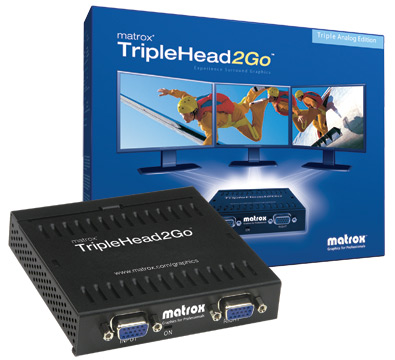
The Matrox DualHead2Go product is essentially a small box which allows you to connect two monitors to a PC or Laptop’s single monitor output.
Its advantage over a standard splitter cable or box is that it allows you to view different Windows content on each connected screen rather than just cloning the same output across them all.
The TripleHead2Go version works exactly the same as the DualHead2Go however it allows 3 monitors to connect to your one monitor output.
Installation & Setup
Installing the kit is straightforward, simply install the drivers onto your computer / laptop and then connect the supplied USB and video cables from your PC to the Matrox box.
You are now able to connect up the 2 or 3 monitors into the other side of the product.
Windows setup is simply a matter of accessing the display properties settings and setting the correct screen resolutions, the settings chosen depends on the number and size of the monitors connected.
The way the kit works is by making Windows think it has one large screen connected rather than 2 or 3 separate screens therefore you have to set a resolution which incorporates all the screens.
For example, if you have three 19” monitors and you want each to have a screen resolution of 1280 x 1024 then you should set the resolution to 3840 x 1024.
General Usage
Once setup of the equipment has been completed you are ready to take advantage of the extra screen space. Like with standard multi monitor setups, you can drag your mouse and programs to any position on any screen by simply moving left or right of the edge of you main screen.
Picture quality is good across the screens and it has no problems displaying video or other graphically intensive software such as games or 3D animations.
Issues to Consider
One drawback of using these kits is that hitting the standard ‘Maximise’ button found in the top right of any Window or program will expand the program across all the screens connected through the Matrox box.
The reason for this is that the kits make Windows think it has one large widescreen connected to it so it rightly maximises programs across the full widescreen monitor it thinks it is hooked up to.
Another consideration is that all the connected screens must have the same resolution settings. Although you can physically connect a 19” and a 24” screen up to the same DualHead2Go box, the resolutions must be identical so you lose the extra screen real estate benefit of the 24” panel.
One final thing to mention is that the screens should be physically positioned next to each other on your desk, there is no way to tell Windows that the screens are not situated together so you will experience weird mouse behaviour if you don’t co-locate them.
Versions Available
There are both analogue and digital editions of both the DualHead and TripleHead2Go kits.
Analogue versions support only VGA monitors up to a maximum resolution of 1280 x 1024 per screen which is basically 17” or 19” (non- widescreen) panels.
The Digital editions support DVI monitors and VGA (with adapters) and can reach 1680 x 1050 resolutions (~22” widescreens) for each VGA or DVI monitor connected.
Strangely both the DualHead2Go and TripleHead2Go kits can also support dual DVI screen resolutions of 1920 x 1200, but the Triple kit can’t support 3 monitors at this higher resolution…
There are also now DisplayPort versions available however their support screen resolutions are the same as the standard digital edition.
Prices
- DualHead2Go Analogue ~ £120 – Buy Online
- DualHead2Go Digital ~ £160 – Buy Online
- TripleHead2Go Analogue ~ £210 – Buy Online
- TripleHead2Go Digital ~ £270 – Buy Online
Overall Thoughts
Both the dual and triple versions are quick and fairly painless ways of adding extra monitor capabilities to either a desktop PC or laptop computer, and they perform well in terms of picture quality.
As detailed above they have some limitations in terms of screen sizes and positioning however if your happy to operate within these parameters then they can be a useful option to consider, especially for laptops which are traditionally difficult to setup with multi screens.
Written by Darren @ Multiple Monitors
Last Updated: January, 2011